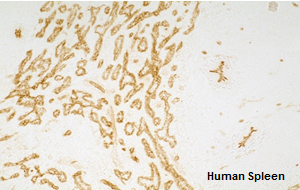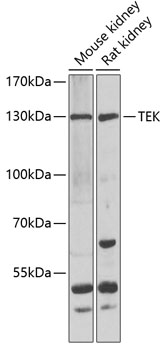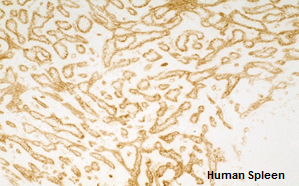
anti-TIE-2 (human), mAb (tek16)
AG-20T-0104
ApplicationsFlow Cytometry, Western Blot, ELISA
Product group Antibodies
ReactivityHuman
TargetTEK
Overview
- SupplierAdipoGen Life Sciences
- Product Nameanti-TIE-2 (human), mAb (tek16)
- Delivery Days Customer10
- ApplicationsFlow Cytometry, Western Blot, ELISA
- CertificationResearch Use Only
- ClonalityMonoclonal
- Clone IDtek16
- Gene ID7010
- Target nameTEK
- Target descriptionTEK receptor tyrosine kinase
- Target synonymsCD202B, GLC3E, TIE-2, TIE2, VMCM, VMCM1, angiopoietin-1 receptor, TEK tyrosine kinase, endothelial, endothelial tyrosine kinase, tunica interna endothelial cell kinase, tyrosine kinase with Ig and EGF homology domains-2, tyrosine-protein kinase receptor TEK, tyrosine-protein kinase receptor TIE-2
- HostMouse
- IsotypeIgG1
- Protein IDQ02763
- Protein NameAngiopoietin-1 receptor
- Scientific DescriptionMonoclonal Antibody. Native human TIE-2 in ELISA experiments and on the surface of different human cell types. Isotype: Mouse IgG1. Clone: tek16. Applications: ELISA, FACS, WB. Lyophilized. TIE-2 acts as cell-surface receptor for ANGPT1, ANGPT2 and ANGPT4 and regulates angiogenesis, endothelial cell survival, proliferation, migration, adhesion and cell spreading, reorganization of the actin cytoskeleton, but also maintenance of vascular quiescence. It has anti-inflammatory effects by preventing the leakage of proinflammatory plasma proteins and leukocytes from blood vessels. It is required for normal angiogenesis and heart development during embryogenesis and for post-natal hematopoiesis. After birth, it activates or inhibits angiogenesis, depending on the context. It inhibits angiogenesis and promotes vascular stability in quiescent vessels, where endothelial cells have tight contacts. In migrating endothelial cells that lack cell-cell adhesions, ANGT1 recruits TEK to contacts with the extracellular matrix, leading to the formation of focal adhesion complexes, activation of PTK2/FAK and of the downstream kinases MAPK1/ERK2 and MAPK3/ERK1 and ultimately to the stimulation of sprouting angiogenesis. - TIE-2 acts as cell-surface receptor for ANGPT1, ANGPT2 and ANGPT4 and regulates angiogenesis, endothelial cell survival, proliferation, migration, adhesion and cell spreading, reorganization of the actin cytoskeleton, but also maintenance of vascular quiescence. It has anti-inflammatory effects by preventing the leakage of proinflammatory plasma proteins and leukocytes from blood vessels. It is required for normal angiogenesis and heart development during embryogenesis and for post-natal hematopoiesis. After birth, it activates or inhibits angiogenesis, depending on the context. It inhibits angiogenesis and promotes vascular stability in quiescent vessels, where endothelial cells have tight contacts. In migrating endothelial cells that lack cell-cell adhesions, ANGT1 recruits TEK to contacts with the extracellular matrix, leading to the formation of focal adhesion complexes, activation of PTK2/FAK and of the downstream kinases MAPK1/ERK2 and MAPK3/ERK1 and ultimately to the stimulation of sprouting angiogenesis.
- ReactivityHuman
- Storage Instruction-20°C,2°C to 8°C
- UNSPSC12352203






